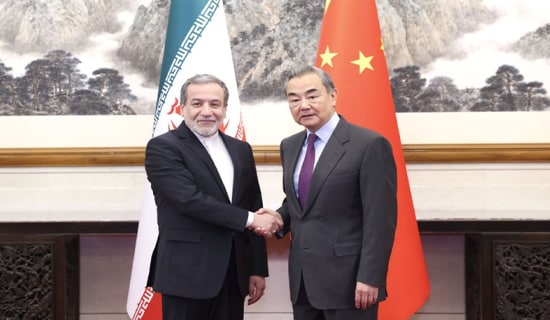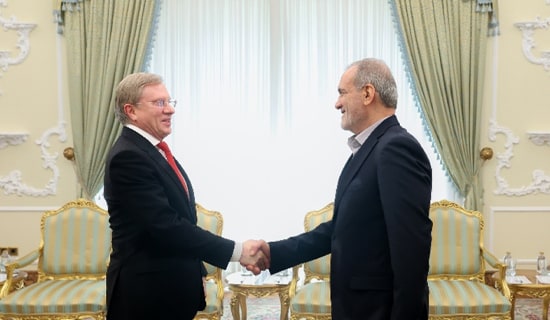On February 25, 2015, Iran's Islamic Revolutionary Guards Corps (IRGC) launched its "Great Prophet 9" multi-force maneuvers. The first day was devoted to naval maneuvers in which IRGC naval air, and missile forces participated, in the Strait of Hormuz and the Persian Gulf; the second day is to be devoted to land maneuvers.
The ceremony kicking off the maneuvers included Majlis speaker Ali Larijani, IRGC commander Mohammad Ali Jafari, IRGC Missile and Air Force commander Amir Ali Hajizadeh, IRGC Navy commander Ali Fadavi, and IRGC land forces commander Mohammad Pakpour.
The focus of the naval maneuvers was a combat scenario of an attack on U.S. naval forces, the centerpiece of which was the sinking of a U.S. aircraft carrier; missile capabilities and naval minelaying were also drilled.
According to IRGC officials, sinking U.S. aircraft carriers is an important part of Iran's warfare strategy. IRGC deputy commander Hossein Salami said in a February 9, 2015 television interview that IRGC forces were practicing sinking an American aircraft carrier with cruise and ballistic missiles (see MEMRI TV Clip No. 4793 - Iranian General Salami: We Tested Sinking Aircraft Carriers with Cruise and Ballistic Missiles).
IRGC naval commander Ali Fadavi said in a February 25 Press TV interview that the IRGC navy can sink the giant U.S. aircraft carriers if they pose a threat to Iran's maritime interests. Previously, on May 6, 2014, he said, "For many long years we have been building, and sinking, destroyers, cruisers, and frigates like those of the Americans. In the diverse operations that we have carried out, we have even sunk a model of their vessels within 50 seconds."[1]
(To view today's naval maneuvers, click here; see also MEMRI TV Clip No. 4799, Iranian Missiles Sink Life-Size Model of U.S. Aircraft Carrier in Strait of Hormuz Navy Drill).
The Purpose Of The Maneuvers - Emphasizing Resistance To The U.S., Boosting Iran's Regional Standing
The maneuvers were aimed at emphasizing the Iranian regime's resistance to the U.S. and at boosting Iran's status as a power in and defender of the region. Kicking off the exercises, Majlis speaker Ali Larijani said: "Iran's military technology can [also] be in the hands of neighboring countries, and they can rely on the military might of Iran... which can, with the other countries' assistance, guarantee regional security. The capabilities of Iran's armed forces are at the disposal of the countries of the region, and against foreign military powers... The countries of the region must know that they [the West, led by the U.S.] cannot change the regional situation by using aircraft carriers for reinforcement."[2]
IRGC commander Mohammad Ali Jafari said at the ceremony: "We are sending all the Persian Gulf countries a message of the might of the Islamic Republic of Iran - a message of security and peace in the Persian Gulf region and the Strait of Hormuz. We have proven our brotherhood [with the countries of the region]. Our problem is with enemies who are not from region."[3]
IRGC naval commander Ali Fadavi said on the occasion: "It is possible to use a special strategy against enemies, in the Strait of Hormuz, anytime, anywhere."[4]
The website Tasnim, which is close to the IRGC, called the maneuvers "a nightmarish display for American Marines in the Strait of Hormuz."[5]
Taking Over And Destroying Nimitz-Class Aircraft Carrier

(Photos courtesy of Tasnim, Iran)
In the maneuvers, IRGC naval forces drilled the destruction of an American Nimitz-class aircraft carrier; the IRGC navy had prepared a mockup of one for this purpose.[6] However, the websites Defa Press and Yjc.ir, which are close to the IRGC, reported that after missiles struck the vessel, it was also taken over by IRGC naval special forces.
According to the reports, "the carrier was attacked with 400 107mm rockets as well as by four Nasr anti-ship missiles fired from IRGC speedboats."[7] It was also reported that "after the pinpoint-accuracy advanced missiles fired by IRGC naval forces struck the aircraft carrier model, fighters from a special [IRGC] naval unit took over the warship."[8]
The Nimitz model was also attacked with rockets fired from Bell 206 and Mil Mi-17 helicopters.[9] Additionally, Khalij-e Fars ballistic missiles with a range of 270 km were fired at the model from Jask Island in southern Iran.[10]
Tasnim explained: "The model of the American warship placed as a target in the area of the maneuvers was of a Nimitz-class aircraft carrier. The Nimitz is 333 meters long, and this model was built to those specifications."[11]
IRGC naval commander Fadavi explained: "This aircraft carrier is the size of a city and houses 6,000 soldiers and 3,000 naval staff... The [U.S. Navy] commander says, 'Save us from the gunpowder in the aircraft carrier' because American warships have stockpiles of equipment such as missiles and rockets, and any direct hit by enemy munitions will cause these to explode inside the warship. This in itself is an important factor in destroying warships."[12] He added, according to a February 25 Fars report: "Next week the IRGC will be supplied with Ghadir cruise missiles with a range of 300 km. The range of our missiles reaches to the most southern naval point in the region; we are aiming at moving targets from Pasabandar [Iran's southernmost point] to the northern Persian Gulf."
Laying Sea Mines
IRGC navy speedboats also practiced laying sea mines in the Strait of Hormuz. IRGC naval commander Fadavi said: "Iran has a wide array of sea mines that the Americans will never guess exist. These mines have the ability to regulate their depth in the water."[13] IRGC deputy commander Hossein Salami and Fadavi both said, "Today, some of the IRGC's naval capabilities that can be revealed have been displayed. We also have secret capabilities that we will only reveal on the battlefield."[14]
Photos: Sinking The Nimitz[15]


Photos: Taking Over The Nimitz[16]

Photos: Top Iranian Officials Observe Maneuvers[17]

Left to right: IRGC land forces commander Mohammad Pakpour, Majlis speaker Ali Larijani, IRGC commander Mohammad Ali Jafari

Left to right: Majlis speaker Ali Larijani, IRGC commander Mohammad Ali Jafari, IRGC Navy commander Ali Fadavi
Endnotes:
[1] Fars (Iran), May 6, 2014.
[2] Tasnim (Iran), February 25, 2015.
[3] Tasnim (Iran), February 25, 2015.
[4] Tasnim (Iran), February 25, 2015.
[5] Tasnim (Iran), February 25, 2015.
[6] On May 6, 2014, Ali Fadavi told Fars that the IRGC navy was constructing a model of an American aircraft carrier in order to practice sinking it.
[7] Tasnim (Iran), February 25, 2015.
[8] Defapress.ir, Yjc.ir, February 25, 2015.
[9] Defapress.ir, February 25, 2015.
[10] Defapress.ir, February 25, 2015.
[11] Tasnim (Iran), February 25, 2015.
[12] Tasnim (Iran), February 25, 2015.
[13] Tasnim (Iran), February 25, 2015.
[14] Tasnim (Iran), February 25, 2015.
[15] Tasnim (Iran), Defapress.ir, @Hosseindalirian, February 25, 2015.
[16] Fars (Iran), February 25, 2015.
[17] Tasnim (Iran), February 25, 2015.




